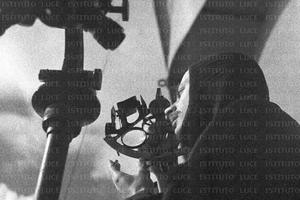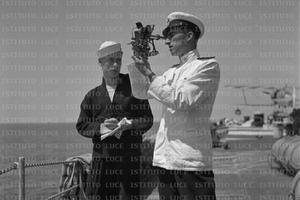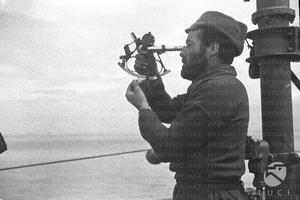Sextant Filotecnica Salmoiraghi "Teaching Section - Royal Italian Submarine School of Pola", 1942
Nautical sextant produced by “Filotecnica Eng. A. Salmoiraghi Milan S.A.”, in 1942, and in use at the "Educational Section" of the "Royal Italian Submarine School of Pola" of the Royal Italian Navy.
This Sextant is accompanied, in addition to the markings indicated above, also by the booklet "Appendix of Tables F", published by the Royal School of Pola, where some fundamental nautical instruments are illustrated and described inside, including the sextant.
The sextant, an instrument used to measure the angle of elevation of a celestial object above the horizon, was widely used during both daytime and nighttime navigation on board submarines, therefore it was essential that students learned its correct use.
The "Educational Section" of the "Royal Italian Submarine School of Pola" was precisely the department responsible for training in the use of this tool.
Taken from the Ministry of Defense: https://www.marina.difesa.it/il-tuo-futuro-e-il-m...
The history of the Navy Submarine School begins over half a century ago. In fact, with a dispatch from April 1940, after a couple of years of studies and projects, the Royal Submarine School was established in Pola.
The need to have an ad hoc institute for the education and training of submariners emerged already at the dawn of the underwater component from the observation of the technical and operational peculiarities of the vehicles, for the conduct of which it was deemed necessary to have all personnel acquire , complete preparation on the equipment and systems on board and on combat tactics, as well as a particular mindset.
The location in Pola was chosen due to its distance from the central theater of the war at sea, the School was established in a complex of structures taken over by the Air Force and appropriately adapted. It was a vast area made up of various buildings where there was accommodation, services, educational facilities and workshops, capable of hosting hundreds of people, including employees and students.
Eight submarines were assigned to the School, which constituted GRUPSOM 12, and a couple of support/target ships. The teaching activity began in September 1940 under the command of Lieutenant Commander Folco Buonamici.
The theoretical and practical training activity was divided into different lines: command training, training for SM officers, for GN officers and Chief Engineers, for non-commissioned officers, for sailors, for horizontal helmsmen. For the latter, in September 1940, the purchase of a certain "German device for the instruction and training of horizontal helmsmen" was considered, perhaps a forerunner of our diving trainer, but of which there is no further news.
In February '42 the School expanded by reorganizing itself into two components: the teaching section (which remained in Pola) and the tactical section (which opened its doors in Rijeka) where it was easier to carry out throwing activities.
In the first three years of its existence, the School trained approximately 700 officers and over 5,000 soldiers of all ranks.
The teaching-training activity continued even during the Second World War.
At the armistice the Submarine School was moved to Taranto where the Submarine Command had been reconstituted, resuming activities in December 1943.
Salmoiraghi was a company resulting from the experience that Angelo Salmoiraghi acquired, after graduating from the Polytechnic of Milan, in Philotechnics, founded in 1865, under the guidance of the founder Ignazio Porro. In Philotechnics, Eng. Salmoiraghi held positions of manager until acquiring ownership in 1873, transforming the name into "Salmoiraghi, Rizzi e C." for the production of optical and topographical instruments. In 1877 the company dissolved and Angelo Salmoiraghi continued the business alone with a new company called Filotecnica Salmoiraghi. At the end of the century he had excellent collaborations: above all that of Francesco Koritska, improving the offer of optical and precision instruments. Under his guidance the company developed considerably, to the point of acquiring a leading role among the producers of optical and precision instruments, the Regia Aeronautica and the Regia Marina.




